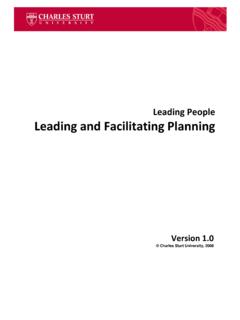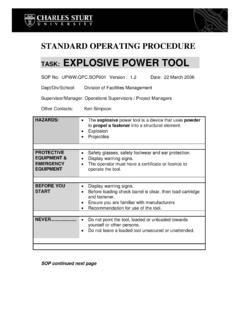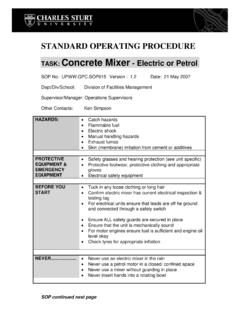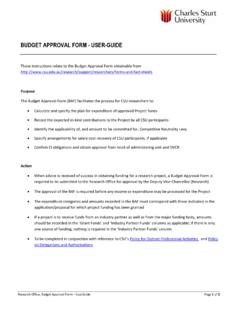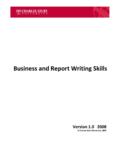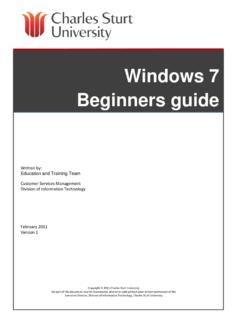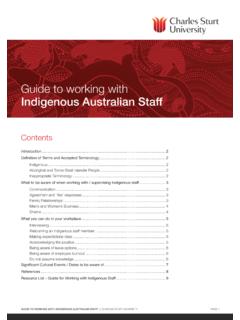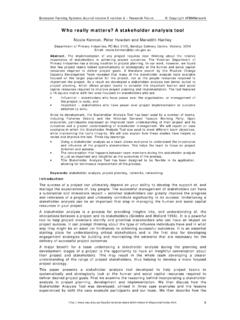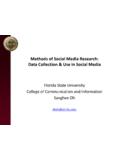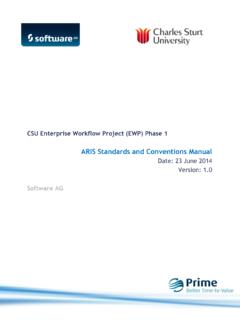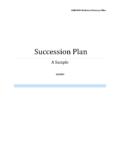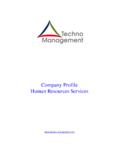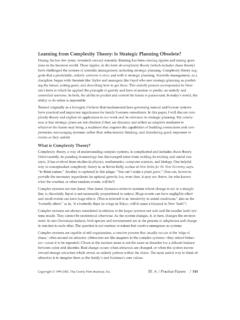Transcription of Leading People Resource Management
1 Leading People Resource Management Version Charles Sturt University, 2008 Acknowledgement: Workplace Productivity Program (WPP) grant from DEEWR. Resources from the Division of Human Resources, the Office of Planning and Audit, Project Service Centre and Division of Finance. Resources from the CSU Frontline Management Program. This module and these resources will be available on the Organisational Development, Division of Human Resources website from second session 2008. Charles Sturt University, 2008 Learning Resource Owner Version: Summary/Overview of changes Leading People Series - Resource Management Carissa Michel September 2008 Table of Contents LEARNING IN THE WORKPLACE 4 PROGRAM OVERVIEW 5 ICONS 5 FRAMEWORK FOR THE DELIVERY OF PROFESSIONAL DEVELOPMENT RESOURCES 6 THE CONTEXT 7 Workplace Activity Resource Management Skills 8 WHY MANAGE RESOURCES 9 Exercise Resource Management 9 THE CSU STRATEGY AND THE INSTITUTIONAL DEVELOPMENT PLAN 10 Exercise Relating University Strategy to Resource Management 10 Exercise Institutional Development Plan 11 QUALITY AND CONTINUAL IMPROVEMENT 12 Exercise Continual Improvement 12 Workplace Learning Activity Continual Improvement 13 SUSTAINABILITY AND THE IMPACT OF CSU 14 CSU Green Office 14 Exercise Sustainability and the Impact of CSU 15 ECONOMIC IMPACT OF CSU 15 Reflection Economic Impact of CSU 15 Key Message - How Resource Management
2 Can improve efficiency 16 WHO MANAGES RESOURCES 17 LEADERS AND MANAGERS 17 Exercise Who Manages Resources 17 Generic Responsibilities of CSU Staff 18 Reflection Managing Others 18 CSU DIVISION OF FINANCE 19 Workplace Learning Activity Financial Resource Management 20 Workplace Learning Activity Financial Reports & Resource Proposals 21 CSU DIVISION OF HUMAN RESOURCES 21 Exercise Human Resources Management 1 22 Team Exercise Human Resources Management 2 23 HOW TO MANAGE RESOURCES 24 CSU TEMPLATES AND INFORMATION AVAILABLE TO AID IN Resource Management 24 Exercise Organising your resources 25 CSU CORE PROCESSES 25 PROCESS MAPPING 27 WORK PROCESS IMPROVEMENT 28 Exercise Work Process Improvement 28 YourCSU Understanding Systems 29 Workplace Learning Activity CSU Systems 29 MANAGING OTHERS 30 CSU Resources and Development for Managers and Supervisors 30 GOVERNANCE AND COMPLIANCE 31 Exercise Governance and Compliance 31 RISK Management 32 Exercise Risk Management 32 Team Exercise Risk Management in your area 33 Reflection Risk Management 34 Workplace Activity Resource Management Skills 35 REFERENCES AND FURTHER READING 36 LIST OF APPENDICIES 37 APPENDIX 1 DESIRED LEADERSHIP BEHAVIOURS FOR BUILDING A PERFORMANCE CULTURE AT CSU 37 APPENDIX 2 ESTIMATING AND SECURING THE NECESSARY RESOURCES 38 APPENDIX 4 FUNCTIONAL LEADERSHIP 40 APPENDIX 5 THE BRIEFING NOTE Resource PROPOSAL 42 LEARNING IN THE WORKPLACE To continue to reinforce your learning from this workshop and prior to the follow up session, when you return to your team use the table below to assist you to reflect on the concepts introduced.
3 Your reflection may also incorporate other behaviours that you have observed from other leaders within your workplace as well. You should aim to identify at least 10 different situations. As part of your reflection, identify some of your key strengths and opportunities for improvement in the way you apply Resource Management within the workplace. What steps might you be able to take to improve your own practice? What was the outcome? Describe this in terms of the characteristics of effective Resource Management . What attributes of effective Resource Management did you display? How have you applied this? Try to think of a specific work situation Effective Resource Management concept O V E R V I E W P a g e | 5 L P S R e s o u r c e M a n a g e m e n t V e r s i o n 1 . 0-2 0 0 8 PROGRAM OVERVIEW This program is designed to introduce some of the key concepts and skills supporting Resource Management at Charles Sturt University (CSU).
4 Although this program does outline many of the important areas of Resource Management , further application of the concepts, principles and skills will help to refine and reinforce your Management practice. To this end, you are encouraged to expand your knowledge and skills by taking up work based or other, more formalised learning opportunities at it s conclusion. Program Objectives: The key objectives of this program are to assist participants: 1.) Identify and develop an understanding of the framework and responsibilities for managing resources at CSU; 2.) Familiarisation with the key principles and systems for Resource Management at CSU; 3.) Identify resources available and apply appropriate strategies to improve Resource Management . ICONS The following icons appear within this learning Resource . They highlight important information as well as activities that can be completed: These are the outcomes that relate to a section of the Resource .
5 An Individual or group exercise. A key message or important point Self-reflection This is a workplace activity O V E R V I E W P a g e | 6 P r o c e s s o f M a n a g i n g C h a n g e V e r s i o n 1 . 0-2008 FRAMEWORK FOR THE DELIVERY OF PROFESSIONAL DEVELOPMENT RESOURCES For leaders and managers to enhance their business knowledge and increase organisational effectiveness and readiness for change. How will the program be delivered? Leading People Series of Workshops: Commencing in 2007 - Change Management - People Management - Resource Management - Planning (Strategic Context) - Business and Report Writing Skills Online Learning Resources: progressively available from June 2008 - Change Management - People Management - Resource Management - Planning (Strategic Context) - Business Reporting Language Leadership Programs and Management Forums - Frontline Management ; Graduate Certificate in University Leadership and Management ; Leadership Development for Women - Senior Managers Forum; senior Women s Network; Middle Managers Forums; Heads of School Forum.
6 Course Coordinators Forum For details on dates refer to the Staff Development Calendar: SKILLING & TOOLS - Discipline, systems, delegations - Project Management tools & templates - Initiatives & funding proposals & mechanisms - Reports committees, Academic Senate etc - Business and report writing skills - Leadership programs & Leading People Series - Online learning resources on OD website 1. FRAMING: - University Strategy & core plans & frameworks - Core processes & University/ Enterprise Model: yourCSU; WPI; BPM - OD Frameworks Delivery: Resources: books, articles, web links Workshops Online learning modules T H E C O N T E X T P a g e | 7 P r o c e s s o f M a n a g i n g C h a n g e V e r s i o n 1 . 0-2008 THE CONTEXT University strategy Charles Sturt University (CSU) in its University Strategy 2007-2011, under Institutional Development, has committed to: Creating a culture that is responsive to organisational change and renewal.
7 An Organisational Change and Renewal Framework has been developed, along with a number of other initiatives, some outlined below, to facilitate the creation of this culture. Workplace Productivity Program (WPP) and the Enterprise Model Organisational culture & communication University Strategy Institutional Development - Organisational Culture (& Change) - Service Alignment - Workforce Planning - Sustainability Work Process Improvement (WPI) 2006 Organisational Development Frameworks: - Leadership & Management - Performance - Continual PD - Change Management Workplace Productivity Program (WPP) - Enterprise model yourCSU - Organisational Change & Renewal Framework - PD resources for leaders & managers (YOU) - WPI Stage 2: Business Process Management (BPM) Business Knowledge modules & Leading People Series: - Change Management - People Management - Resource Management - Planning PD delivery & development.
8 OD & WPP CSU Project Management Framework W H Y M A N A G E R E S O U R C E S P a g e | 8 P r o c e s s o f M a n a g i n g C h a n g e V e r s i o n 1 . 0-2008 Workplace Activity Resource Management Skills Q: Has your division/faculty identified Resource Management skills and capabilities needed to deliver its core activities and services? Where there are gaps what strategy has been put in place to develop skills? W H Y M A N A G E R E S O U R C E S P a g e | 9 P r o c e s s o f M a n a g i n g C h a n g e V e r s i o n 1 . 0-2008 WHY MANAGE RESOURCES Monitoring and evaluation of resources helps to determine if you are on track to producing the desired results. Resource Management helps to: identify what works, and what activities should continue improve actions where they are less effective change actions if they are ineffective Exercise Resource Management Resource Management is the efficient and effective deployment of an organisation's resources when they are needed.
9 Such resources may include financial resources, inventory, human skills, production resources, or information technology (IT). In the realm of project Management , Resource Management refers to processes, techniques and philosophies and to the best approach for allocating resources. Source: Q. List the most important reasons for you to effectively manage the resources that have been made available to you? Q. Think carefully about all the different areas you are responsible for and/or report to that require your stewardship of resources and list them below? What are the reasons. W H Y M A N A G E R E S O U R C E S P a g e | 10 P r o c e s s o f M a n a g i n g C h a n g e V e r s i o n 1 . 0-2008 THE CSU STRATEGY AND THE INSTITUTIONAL DEVELOPMENT PLAN One of the key values of the CSU Strategy 2007 to 2011 is to ensure economic, social and environmental sustainability including the responsible stewardship of resources.
10 Source: CSU Strategy 2007 2011: Exercise Relating University Strategy to Resource Management Five Resource areas needed to support an organisation s vision and Strategic Plan: 1. Structures, which includes the physical layout of the organisation, the organisation design (the way it groups and links its employees and functions together), and it s financial and budgeting arrangements yourCSU - Charles Sturt University 2. Staff (or People ), which includes its recruitment and selection processes, succession plans and capabilities, and the attitudes of its employees Workforce Planning - Division of Human Resources - Charles Sturt University 3. Skills, which includes training for the future as well as the present in technical and interpersonal skills, leadership, and strategic and conceptual thinking. Organisational Development - Division of Human Resources - Charles Sturt University 4.
